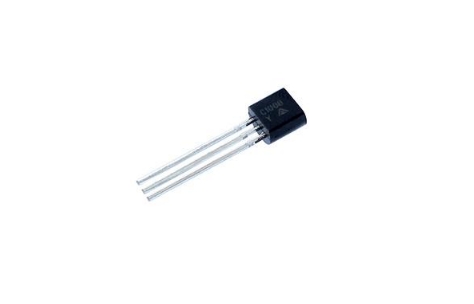The MMBT2222A, an extensively utilized NPN-type Bipolar Junction Transistor (BJT), is renowned for its exceptional electrical characteristics and versatile applications. This article delves into the primary characteristics, specification parameters, and various application fields of the MMBT2222A.
- Key Characteristics of the MMBT2222A
The MMBT2222A transistor boasts several impressive technical specifications and characteristics, making it an ideal choice for numerous electronic devices.
NPN Transistor Type: The MMBT2222A is an NPN-type transistor with high current and voltage handling capabilities. This type of transistor is commonly used for signal amplification, current control, and as a switch in electronic devices.
High Reliability Design: The MMBT2222A features a high-reliability design that meets the rigorous demands of various applications. Its stability and reliability ensure outstanding performance in automotive electronics, industrial control, consumer electronics, and other fields.
Wide Operating Temperature Range: The MMBT2222A operates within a wide temperature range of -55°C to 150°C. This characteristic allows it to function stably under various environmental conditions, adapting to diverse application scenarios.
Low Saturation Voltage: The MMBT2222A boasts a low saturation voltage, which means it reduces energy consumption in circuits when in the conduction state, enhancing energy efficiency.
High Characteristic Frequency: The MMBT2222A has a high characteristic frequency, facilitating rapid signal processing and transmission. This makes it excel in high-frequency signal amplification and processing, making it an ideal choice for communication equipment such as RF amplifiers, modems, and antenna drivers.
Diverse Packaging Forms: The MMBT2222A typically adopts the SOT-23 packaging format, making it easy to combine with other components to meet different design requirements.
- Specification Parameters of the MMBT2222A
The specification parameters of the MMBT2222A detail its electrical characteristics and performance indicators. Here are its main specification parameters:
Collector-Emitter Voltage (Vceo): 40V. This is the maximum voltage between the collector and emitter; exceeding this value may damage the transistor.
Cutoff Frequency (ft): Typically 300MHz. This is the highest frequency of the signal that the transistor can amplify, with high-frequency characteristics making the MMBT2222A excel in high-frequency applications.
Power Dissipation (Pd): 250mW. This is the maximum power loss that the transistor can withstand during operation.
Maximum Continuous Collector Current (Ic): 150mA (some versions can reach 500mA). This is the maximum collector current that the transistor can handle continuously.
DC Current Gain (hfe): Minimum 100. This reflects the amplification capability of the transistor under DC conditions.
Saturation Voltage (Vce sat): Maximum 300mV. This is the collector-emitter voltage in the saturation state; a low saturation voltage helps reduce circuit energy consumption.

Collector-Base Voltage (VCBO): 75V. This is the maximum reverse voltage between the collector and base.
Emitter-Base Voltage (VEBO): 6V. This is the maximum reverse voltage between the emitter and base.
III. Application Fields of the MMBT2222A
Due to its excellent parameters and characteristics, the MMBT2222A is widely welcomed. Here are its main application fields:
Automotive Electronics: The MMBT2222A can handle high voltages and currents while boasting low saturation voltage and high characteristic frequencies, making it widely used in automotive electronics. It can be applied to ignition systems, horn drivers, body control, and other areas, providing efficient, stable, and reliable circuit control for automobiles.
Industrial Control: The high reliability and withstand capacity of the MMBT2222A make it ideal for industrial control applications. It can be used in various sensor signal amplification, switching, and driving circuits for efficient data processing and control operations.
Communication Equipment: The high-frequency characteristics of the MMBT2222A make it an ideal choice for RF amplifiers, modems, antenna drivers, and other communication equipment. It enhances communication quality and data transmission speed, promoting the miniaturization and integration of communication equipment.
Consumer Electronics: The small size and high reliability of the MMBT2222A make it widely used in consumer electronics. For example, it can be used in power amplification, switching, and control circuits in mobile phones, tablets, audio equipment, and other products.
Analog Circuits: In analog circuits, the MMBT2222A can be used to build various basic circuits such as oscillators and filters. Its low noise figure and fast switching speed make it excel in these applications.
Conclusion
In summary, the MMBT2222A, as a commonly used low-power transistor, has important applications in various electronic devices. It offers stable and reliable performance across a wide range of applications, meeting the rigorous demands of diverse scenarios. By understanding the primary characteristics and specification parameters of the MMBT2222A, we can better select and utilize this transistor, providing strong support for the design and manufacture of electronic devices.
ICQIUK Electronics is a hybrid IC distributor of electronic components.
Established in March 2020 ,We have excellent global sales team and perfect sales network.We also have logistics warehouses in Hong Kong and Shenzhen.Our company is characterized by high-quality elite team and the business of our company has scattered more than 30 countries in all regions of the world.





